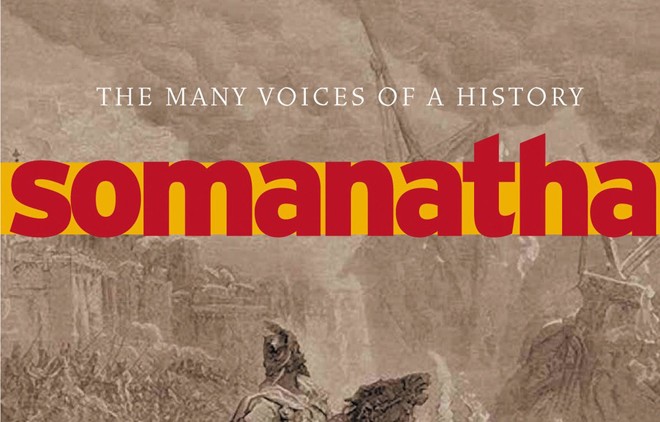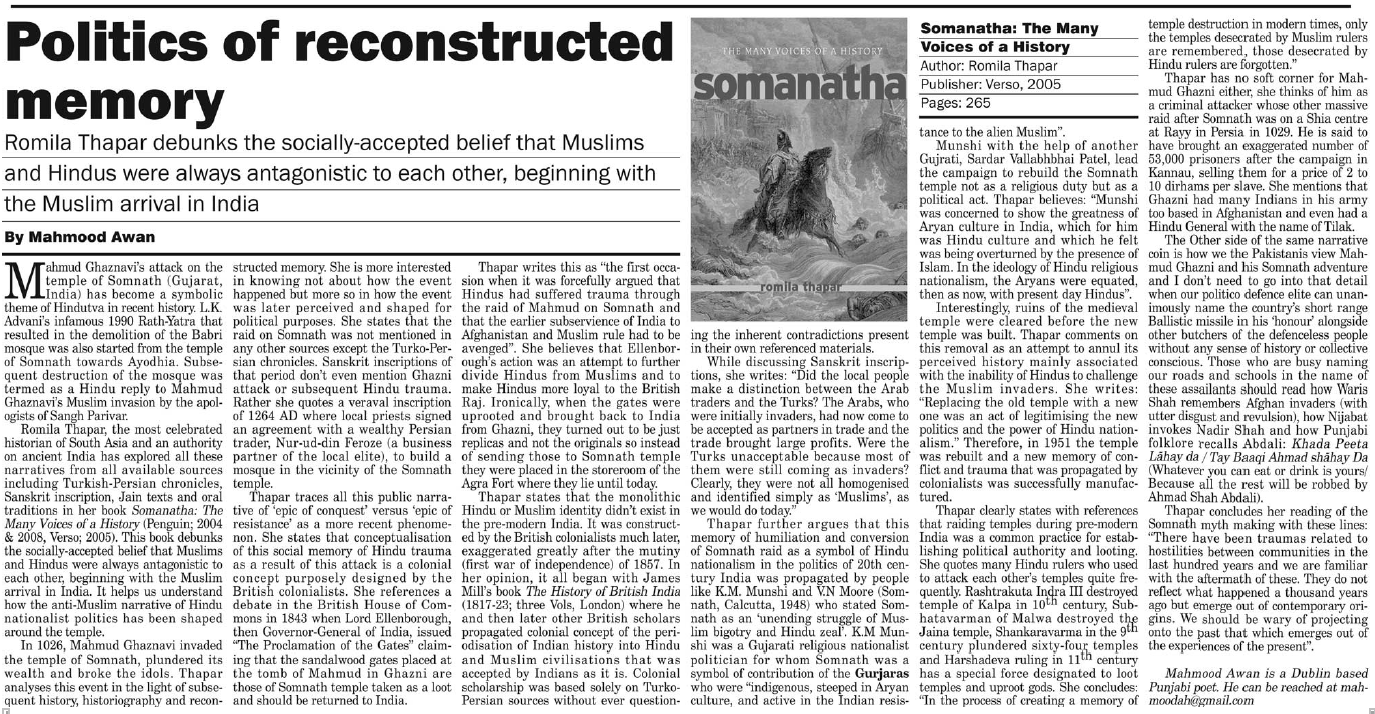Mahmood Awan (The News on Sunday, 8th November 2015)
Mahmud Ghaznavi’s attack on the temple of Somnath (Gujarat, India) has become a symbolic theme of Hindutva in recent history. L.K. Advani’s infamous 1990 Rath-Yatra that resulted in the demolition of the Babri mosque was also started from the temple of Somnath towards Ayodhia. Subsequent destruction of the mosque was termed as a Hindu reply to Mahmud Ghaznavi’s Muslim invasion by the apologists of Sangh Parivar.
Romila Thapar, the most celebrated historian of South Asia and an authority on ancient India has explored all these narratives from all available sources including Turkish-Persian chronicles, Sanskrit inscription, Jain texts and oral traditions in her book Somanatha: The Many Voices of a History (Penguin; 2004 & 2008, Verso; 2005). This book debunks the socially-accepted belief that Muslims and Hindus were always antagonistic to each other, beginning with the Muslim arrival in India. It helps us understand how the anti-Muslim narrative of Hindu nationalist politics has been shaped around the temple.
In 1026, Mahmud Ghaznavi invaded the temple of Somnath, plundered its wealth and broke the idols. Thapar analyses this event in the light of subsequent history, historiography and reconstructed memory. She is more interested in knowing not about how the event happened but more so in how the event was later perceived and shaped for political purposes. She states that the raid on Somnath was not mentioned in any other sources except the Turko-Persian chronicles. Sanskrit inscriptions of that period don’t even mention Ghazni attack or subsequent Hindu trauma. Rather she quotes a veraval inscription of 1264 AD where local priests signed an agreement with a wealthy Persian trader, Nur-ud-din Feroze (a business partner of the local elite), to build a mosque in the vicinity of the Somnath temple.
Thapar traces all this public narrative of ‘epic of conquest’ versus ‘epic of resistance’ as a more recent phenomenon. She states that conceptualisation of this social memory of Hindu trauma as a result of this attack is a colonial concept purposely designed by the British colonialists. She references a debate in the British House of Commons in 1843 when Lord Ellenborough, then Governor-General of India, issued “The Proclamation of the Gates” claiming that the sandalwood gates placed at the tomb of Mahmud in Ghazni are those of Somnath temple taken as a loot and should be returned to India.
Thapar writes this as “the first occasion when it was forcefully argued that Hindus had suffered trauma through the raid of Mahmud on Somnath and that the earlier subservience of India to Afghanistan and Muslim rule had to be avenged”. She believes that Ellenborough’s action was an attempt to further divide Hindus from Muslims and to make Hindus more loyal to the British Raj. Ironically, when the gates were uprooted and brought back to India from Ghazni, they turned out to be just replicas and not the originals so instead of sending those to Somnath temple they were placed in the storeroom of the Agra Fort where they lie until today.
Thapar states that the monolithic Hindu or Muslim identity didn’t exist in the pre-modern India. It was constructed by the British colonialists much later, exaggerated greatly after the mutiny (first war of independence) of 1857. In her opinion, it all began with James Mill’s book The History of British India (1817-23; three Vols, London) where he and then later other British scholars propagated colonial concept of the periodisation of Indian history into Hindu and Muslim civilisations that was accepted by Indians as it is. Colonial scholarship was based solely on Turko-Persian sources without ever questioning the inherent contradictions present in their own referenced materials.
While discussing Sanskrit inscriptions, she writes: “Did the local people make a distinction between the Arab traders and the Turks? The Arabs, who were initially invaders, had now come to be accepted as partners in trade and the trade brought large profits. Were the Turks unacceptable because most of them were still coming as invaders? Clearly, they were not all homogenised and identified simply as ‘Muslims’, as we would do today.”
Thapar further argues that this memory of humiliation and conversion of Somnath raid as a symbol of Hindu nationalism in the politics of 20th century India was propagated by people like K.M. Munshi and V.N Moore (Somnath, Calcutta, 1948) who stated Somnath as an ‘unending struggle of Muslim bigotry and Hindu zeal’. K.M Munshi was a Gujarati religious nationalist politician for whom Somnath was a symbol of contribution of the Gurjaras who were “indigenous, steeped in Aryan culture, and active in the Indian resistance to the alien Muslim”.
Munshi with the help of another Gujrati, Sardar Vallabhbhai Patel, lead the campaign to rebuild the Somnath temple not as a religious duty but as a political act. Thapar believes: “Munshi was concerned to show the greatness of Aryan culture in India, which for him was Hindu culture and which he felt was being overturned by the presence of Islam. In the ideology of Hindu religious nationalism, the Aryans were equated, then as now, with present‑day Hindus”.
Interestingly, ruins of the medieval temple were cleared before the new temple was built. Thapar comments on this removal as an attempt to annul its perceived history mainly associated with the inability of Hindus to challenge the Muslim invaders. She writes: “Replacing the old temple with a new one was an act of legitimising the new politics and the power of Hindu nationalism.” Therefore, in 1951 the temple was rebuilt and a new memory of conflict and trauma that was propagated by colonialists was successfully manufactured.
Thapar clearly states with references that raiding temples during pre-modern India was a common practice for establishing political authority and looting. She quotes many Hindu rulers who used to attack each other’s temples quite frequently. Rashtrakuta Indra III destroyed temple of Kalpa in 10th century, Subhatavarman of Malwa destroyed the Jaina temple, Shankaravarma in the 9th century plundered sixty-four temples and Harshadeva ruling in 11th century has a special force designated to loot temples and uproot gods. She concludes: “In the process of creating a memory of temple destruction in modern times, only the temples desecrated by Muslim rulers are remembered, those desecrated by Hindu rulers are forgotten.”
Thapar has no soft corner for Mahmud Ghazni either, she thinks of him as a criminal attacker whose other massive raid after Somnath was on a Shia centre at Rayy in Persia in 1029. He is said to have brought an exaggerated number of 53,000 prisoners after the campaign in Kannau, selling them for a price of 2 to 10 dirhams per slave. She mentions that Ghazni had many Indians in his army too based in Afghanistan and even had a Hindu General with the name of Tilak.
The Other side of the same narrative coin is how we the Pakistanis view Mahmud Ghazni and his Somnath adventure and I don’t need to go into that detail when our politico defence elite can unanimously name the country’s short range Ballistic missile in his ‘honour’ alongside other butchers of the defenceless people without any sense of history or collective conscious. Those who are busy naming our roads and schools in the name of these assailants should read how Waris Shah remembers Afghan invaders (with utter disgust and revulsion), how Nijabat invokes Nadir Shah and how Punjabi folklore recalls Abdali: Khada Peeta Lãhay da / Tay Baaqi Ahmad shãhay Da (Whatever you can eat or drink is yours/ Because all the rest will be robbed by Ahmad Shah Abdali).
Thapar concludes her reading of the Somnath myth making with these lines: “There have been traumas related to hostilities between communities in the last hundred years and we are familiar with the aftermath of these. They do not reflect what happened a thousand years ago but emerge out of contemporary origins. We should be wary of projecting onto the past that which emerges out of the experiences of the present”.
Somanatha: The Many Voices of a History
Author: Romila Thapar
Publisher: Verso, 2005
Pages: 265
Published on 8th November 2015 in The News on Sunday.
https://www.thenews.com.pk/tns/detail/559728-politics-reconstructed-memory


